The winner of the 2016 Carnegie Medal was announced today: the award went to Sarah Crossan for One, a verse novel about conjoined twins. In addition, the inaugural Amnesty CILIP Honour was awarded to Robin Talley’s Lies We Tell Ourselves, and the Kate Greenaway Award went to Chris Riddell for his illustrations to Neil Gaiman’s The Sleeper and the Spindle. Congratulations to all the winners.
I have been shadowing this year’s Carnegie award and had meant to blog each title as we went along, but these good intentions fell by the wayside. So instead I’m doing a brief round-up blog on all this year’s titles. This post and the next will deal with all the ‘runners up’, and then I’ll discuss One and Lies We Tell Ourselves, along with a few musings on the award as a whole. There will be spoilers here, though I’ll try to keep them to a minimum.
Frances Hardinge – The Lie Tree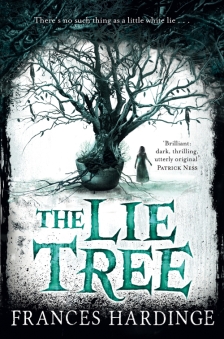
A fantasy novel with a ‘alt Victorian’ setting, which deals with the crisis of faith occasioned by Darwinism and the constraints of Victorian gender norms. Faith and her family have moved to an isolated island community, ostensibly because her father, a noted expert on fossils, has been invited to work on an archaelogical dig on the island, but in reality (it becomes clear) because her father has suffered a blow to his reputation which will result in the family being socially ostracised. Isolation is not enough, however, and before long Faith’s father has been found dead and the island is alive with rumours about his exposure as a scientific fraud. Faith discovers her father’s secret: a mysterious plant known as the Mendacity Tree which appears to deliver revelations when ‘fed’ a diet of lies. Her father’s fake fossils seem to have been created in service of the Tree, and Faith quickly discovers for herself how lies and rumours can take on a life of their own.
I read this before the Carnegie shortlist was announced. I approached it with high expectations, partly because the novel won the Costa Prize this year but largely because I really like Hardinge’s writing. Her novel Cuckoo Song was on last year’s Carnegie shortlist and I felt passionately that it should have been the winner. Perhaps the novel suffered a bit from my high expectations, but I didn’t think it lived up to Cuckoo Song. I certainly enjoyed it, but both in terms of writing style and in terms of plot I found it a little clunky at points. One of the major themes running through the novel is the issue of gender: Faith begins the novel idolising her father and despising her mother, but as the narrative progresses it becomes clear to both the reader and Faith herself that her father is deeply flawed (and pretty unlikeable) while her mother’s apparent vapidity is a weapon she wields in the context of a highly gendered world. This gets hammered home a bit too hard, however: at one point Faith’s father literally tells her that ‘a girl cannot be brave, or clever, or skilled as a boy can’. I suppose that the target reader of this novel might need a little bit more help recognising the way Victorian gender norms operate than I do, but I found that the degree to which the novel tells rather than shows interfered with the development of Faith’s character. She never felt completely real to me, because she was always being used as a kind of ideological example. This is a rather harsh way of doing it – and in reality I enjoyed the book quite a lot more than this sounds – but it was disappointing because one of the things I really loved about Cuckoo Song was the way it very gradually and subtly asked both the protagonist and the reader to reconsider their understanding of the world.
The Lie Tree is a very good novel, and I enjoyed the ending, which was something of a romp (surprise lesbians as a deus ex machina!), but whereas last year I felt Hardinge was robbed, I didn’t feel passionately about her this year. In fact, I’m a little disappointed that it was this book that received the Costa, as I think this is neither Hardinge’s best work nor the best children’s literature has to offer.
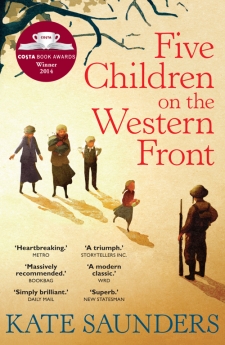 Kate Saunders – Five Children on the Western Front
Kate Saunders – Five Children on the Western Front
As the title suggests, this is essentially E Nesbit fanfiction. It picks up from the episode in The Story of the Amulet in which the children visit their own near future but – as the author says in her afternote to the book – she knew what Nesbit could not about what their future might contain. The book reintroduces us to the original four children, now almost grown up, plus one more – Edie – of Kate Saunders’ invention, and explores their lives in the context of World War One. The Psammead reappears once more, and it becomes apparent that he needs to reckon with the crimes of his own past while the children grapple with the problems of their present.
I bought Five Children on the Western Front shortly after it came out, and read the prologue, in which the children visit their friend the Professor in the future. The chapter closes with the children wondering why they could see no photos of the grown-up boys in the Professor’s study, while ‘Far away in 1930, in his empty room, the old professor was crying’. I found this incredibly powerful, and so sad that I closed the book and didn’t pick it up again until I came to it on the Carnegie shortlist. I love Nesbit’s books, and this prologue works perfectly as a piece of futurefic which reminds you of the tragedy which was to come to the generation portrayed in her books. It’s much harder to sustain this over the course of an entire novel, and while I liked this book I don’t think it entirely succeeds.
The best aspects of the book were in the characterisation. I absolutely believed in the five children and the way they interacted. I especially liked the way Saunders shows the Psammead colliding with their real lives and coming off the worse: whereas Nesbit’s stories are always set in the summer holidays, this book shows the children dealing with school, jobs, and army life. The Psammead is neither as important nor as interesting to them in this context, and their different reactions to him are nicely drawn and often quite humorous.
The historical commentary was less finely drawn. Throughout the novel, the Psammead is forced to deal with various revelations about his past life, when – it turns out – he was a rather despotic god-ruler. He’s forced to acknowledge that he treated his subjects / slaves poorly, that his blithe use of slaves as cannon fodder and his scorn for the ‘slave’ class was wrong. All this has clear parallels for the WW1 setting and serves as a commentary on the things the children are encountering (Robert and Cyril both end up as solders, while Anthea falls in love with a working-class boy they encounter while taking the Psammead to the British Museum). The book suffers from a similar problem to The Lie Tree: in making it clear to her readers where their ideological loyalties should lie, Saunders limits the nuance of her story. In particular, the children are all a little too twenty-first century in their views, and are ready not only to condemn the Psammead for his past behaviour but also to condemn the mores of their own times. It would have been more interesting if the Psammead had been allowed to give as good as he got in terms of criticising their society. In particular, the recurring slave narrative seemed like a missed opportunity: the children could have been forced to examine their own reliance on a society which (while no longer dependent on actual slave labour) actively exploited the poor and was still heavily dependent on the then-thriving Empire. A more subtle handling of this theme could have also given it more resonance for contemporary readers: the underlying implication of the book was that they did bad things in the past, but we are more enlightened now. This is an easy trap to fall into when writing about WW1, I think, but the book was good enough that it really felt like a missed opportunity not to make this a more uncomfortable narrative.
One thing that does make me forgive this book for being slightly less nuanced or daring than it could have been is the fact that it is genuinely for younger readers. It’s the only book on this shortlist which is really aimed at an under twelve readership, so while there was scope to do more with the narrative, it delivers something appropriate for its target audience. I also happen to generally like its ideological slant – but I think there could have been a bit more to it even within the bounds of its younger target audience.
Patrick Ness – The Rest of Us Just Live Here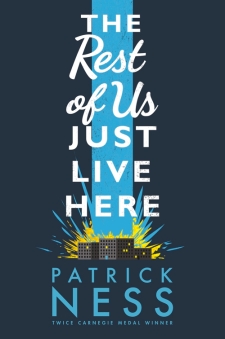
A story about not being the Chosen One. Each chapter of The Rest of Us Just Live Here begins with a ‘chapter summary’ documenting the adventures of the ‘indie kids’ as they battle against supernatural forces. The chapters themselves follow Mikey and his friends, ‘ordinary’ teenagers who are simply dealing with their day-to-day lives rather than tryng to save the world. The book was described to me as ‘Buffy fanfiction about the people in the background’, which is a fair description of its conceit, although it also spoofs a number of other YA genre tropes (there are mentions of a plague of sparkly people, and of people dying beautifully of cancer).
I love Buffy and love fanfiction, and I also think Patrick Ness has produced some of the finest works published for young adults in recent years, so I was excited about this book. As with The Lie Tree, this perhaps meant I had overly high expectations going in, but while I liked this book I didn’t think it lived up to Ness’s earlier works (although to be fair I think the Chaos Walking trilogy is the kind of career defining work that is very difficult to ever match). I enjoyed all the little hat tips to various genre tropes, and it’s clear that Ness is writing from a place of deep affection for the genre even while he’s poking gentle fun at it. The fantasy elements and the realism gradually converge, but I found the degree to which Mikey remains disconnected from the adventures of the indie kids a bit unsatisfying. I’ve actually read quite a bit of Buffy fanfiction with a similar premise, and I think one of the things I enjoy most about that genre is the way it can show how the weird characteristics of Sunnydale shape the ways people live there even when they are not involved or even consciously aware of the supernatural. By contrast, Ness’s teenagers comment on the activities of the indie kids in a rather detached way, and even when they actually start to encounter the indie kids in serious trouble they don’t seem particularly moved by them or inclined to help them. The brilliant Aishwarya writes eloquently about the problems with this in her blog. The funny thing is that that this sense of disconnection is at odds with the message of the book itself, which is really all about community. Ness rejects the idea of the lone Chosen One in favour of a narrative which recognises that everyone is flawed and everyone has their own challenges, but suggests that the way to counter this is by paying attention to one another. So it’s a shame that this isn’t quite reflected in the merging of the two narratives.
I originally read this book in advance of an event with Ness at Seven Stories, at which Ness read a section. I found the book much, much funnier when he was reading it, and it makes me feel it would be worth a reread to see if the humour might ‘sparkle’ a bit more if I were in the right mood. Even without the laugh-out-loud quality it had when he was reading it, I enjoyed the book, and I think teenage readers would definitely enjoy it. But for me, this wasn’t ‘outstanding’ and I’m glad it didn’t end up being Ness’s third Carnegie win.
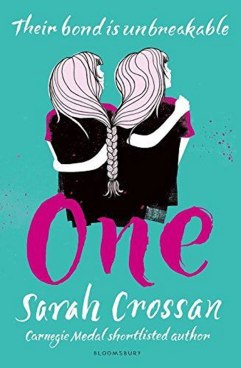
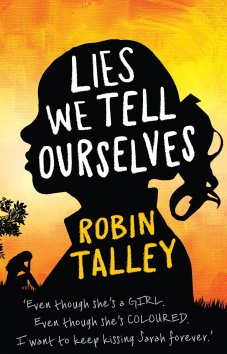

 Kate Saunders – Five Children on the Western Front
Kate Saunders – Five Children on the Western Front